This article analyzes TON's explosive growth and its synergy with Telegram, exploring their impact on the crypto ecosystem, potential as a super app, and current challenges.
Projects like Notcoin and Hamster Kombat have shown remarkable growth, demonstrating TON ecosystem's potential. Their success clearly illustrates the effectiveness of leveraging Telegram's user base for distribution. Their stories are attracting more developers to the ecosystem by proving Telegram's capability to attract users to their applications.
The combination of TON and Telegram has the potential to solve crypto's 'first mile problem'. The low entry barrier and mobile-focus design of Telegram-based applications offer users a chance to gradually adapt to the crypto ecosystem. The T2E (Tap-to-Earn) model has played a significant role in initial user acquisition with its risk-free profitability and intuitive features.
The App Center serves as a centralized hub for discovering and distributing crypto applications within Telegram, significantly enhancing user accessibility. It provides a familiar, app store-like interface that allows users to explore various services without leaving the platform, potentially accelerating crypto adoption.
However, TON is culturally and technically isolated from the mainstream ecosystem, making it challenging to attract developers and integrate with other ecosystems. Its unique structure and programming language create high entry barriers for developers and present disadvantages in terms of compatibility with other blockchain infra and middleware utilization.
Currently, most applications in the TON ecosystem face issues with quality and sustainability, and the user base primarily consists of low-value users. Applications focusing on simple game mechanics and primitive token farming show limitations in long-term user retention and value creation.
TON and Telegram's experiment will be an important milestone for the future of the crypto industry, vividly demonstrating the potential impact of platforms with large user bases on the crypto ecosystem and the challenges and opportunities in the process of crypto's mainstream adoption.
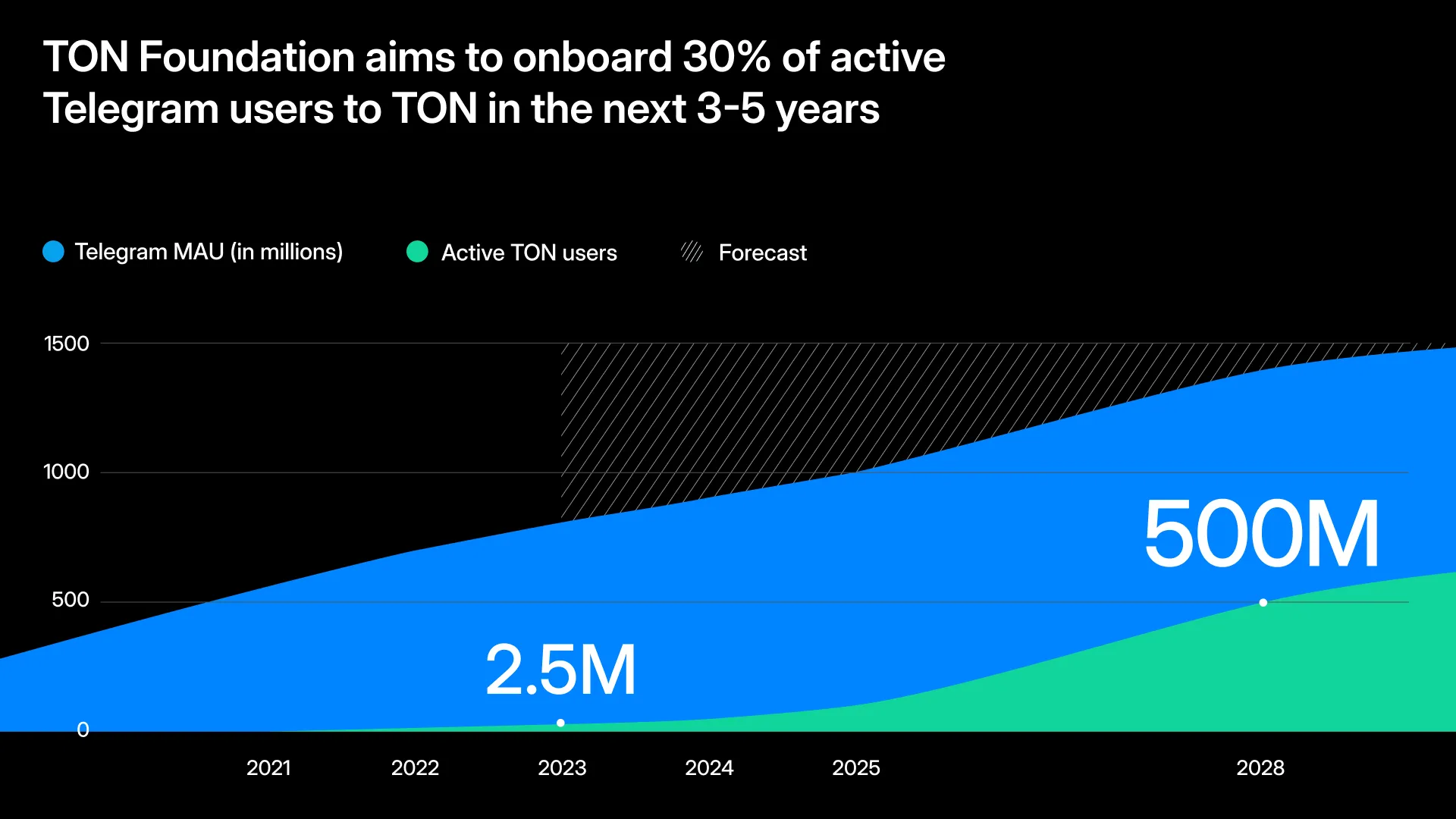
Source: X(@ton_blockchain)
TON's meteoric rise has become impossible to ignore. Throughout this year, the ecosystem has consistently demonstrated impressive achievements in both development and user engagement. The number of monthly active wallets has exploded from a 100k a year ago to a 10 million today. This growth trajectory is remarkable even by Web2 standards, especially considering that other blockchain networks have seen sharp declines in transaction volumes and user numbers since the beginning of the year.
TON's competitive edge is clear. It's built on the back of Telegram, the fourth-largest messaging app globally, boasting nearly a billion monthly active users. Telegram's user base continues to grow steadily, potentially challenging the positions of its larger rivals soon. This grants TON access to a vast social graph, a scale that's unparalleled in the crypto industry. Since Facebook abandoned its Libra project, TON stands as the only major social platform actively working to build an onchain ecosystem with a global user base.
However, despite its immense potential, TON faces significant challenges. Many of the games on the platform are still rudimentary, relying on simple token designs and unsustainable reward models. Most are basic Tap-To-Earn or idle games that offer passive rewards for minimal interaction.
Can Telegram and TON leverage their competitive advantages to become the super app of crypto? This article will explore the current state of the TON ecosystem, its vast potential, and the formidable challenges it must overcome to achieve its ambitious goals.
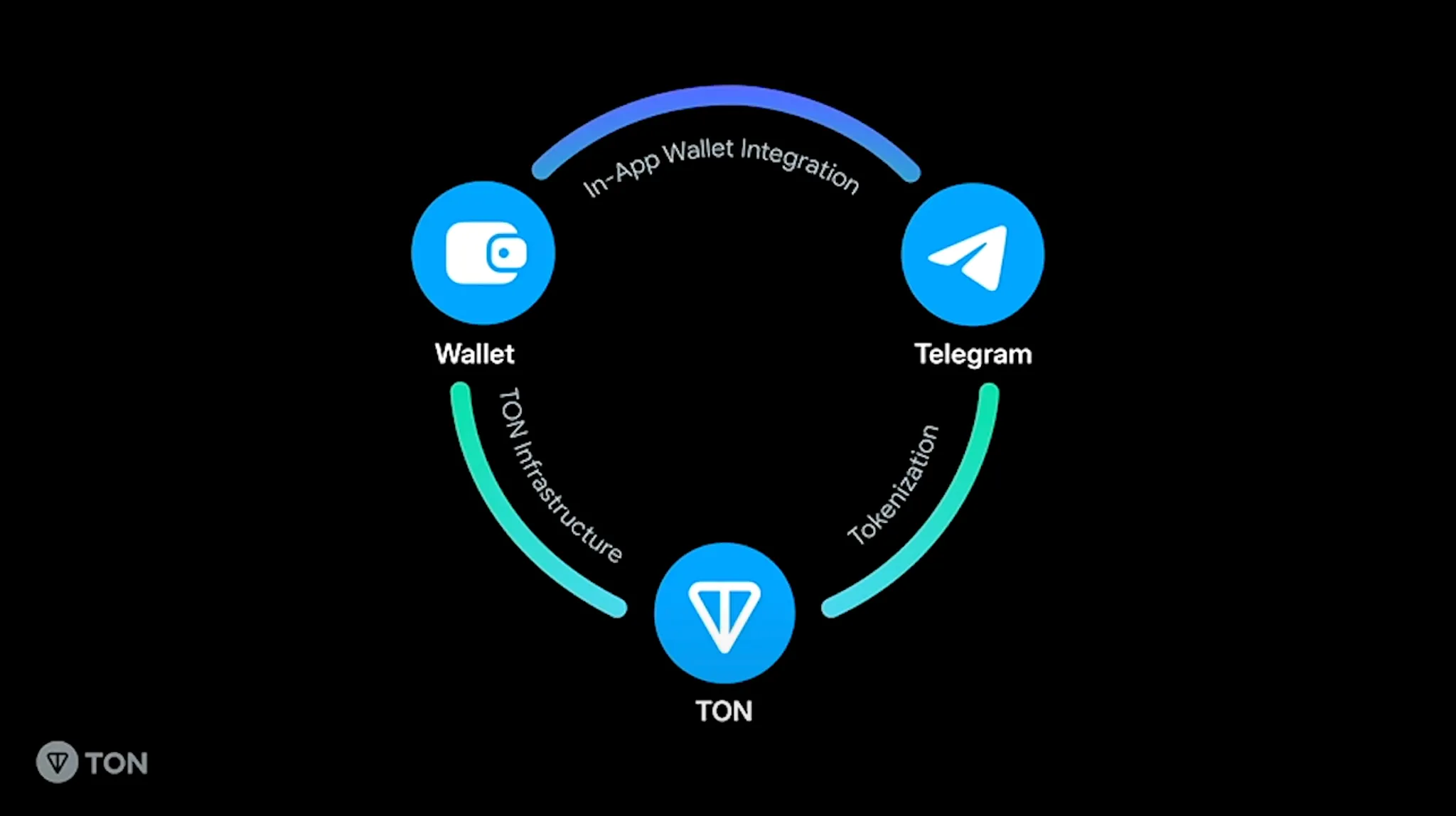
Source: Transforming Telegram to Web3 with Toncoin - TOKEN2049 Singapore 2023
TON's history traces back to the ICO boom of 2017. However, its development was halted due to SEC sanctions amidst a rapidly deflating market bubble. The project was later revived by the community, evolving into the current iteration of TON after numerous challenges.
Up until 2022, TON continued development with initiatives like a username marketplace called Fragment. However, it was largely fading from public consciousness, viewed as a relic of the past. TON's resurgence was declared at a Token2049 session in 2023, where it announced a partnership with Telegram. They unveiled an in-app wallet called Wallet and TON Space, a non-custodial wallet, expressing their intention to focus on users and applications rather than technology and narratives.
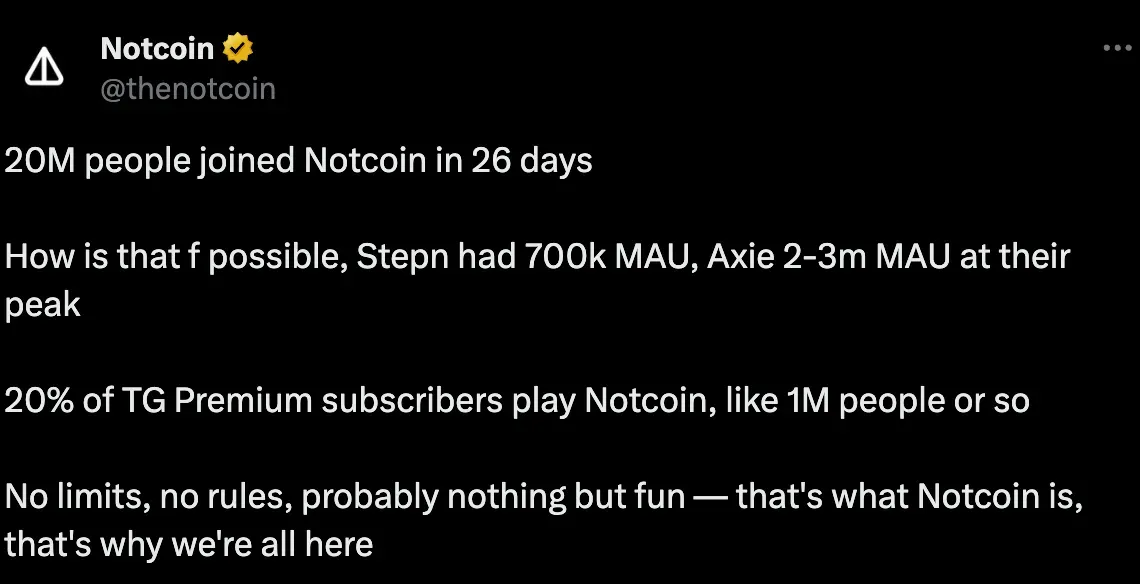
Source: X(@thenotcoin)
Their vision soon bore unexpected fruit with the launch of Notcoin in November 2023. This simple Tap-to-Earn Telegram Mini App (TMA) quickly gained traction, attracting users with its intuitive functionality and air of mystery. Notcoin initially withheld information about its team and project, sparking curiosity with the enigmatic slogan "Probably Nothing."
Notcoin's success was nothing short of phenomenal. During its beta phase alone, it saw over 600,000 users mine a staggering 60 billion Notcoins. By its official launch in January 2024, the user base had swelled to 4 million. This explosive growth outpaced even the most successful GameFi projects like Axie Infinity and STEPN, and remarkably, Notcoin hit the 1 million user milestone faster than ChatGPT. What makes this achievement even more impressive is that it was accomplished without a single dollar spent on marketing, relying entirely on virals and organic spread within the Telegram ecosystem.
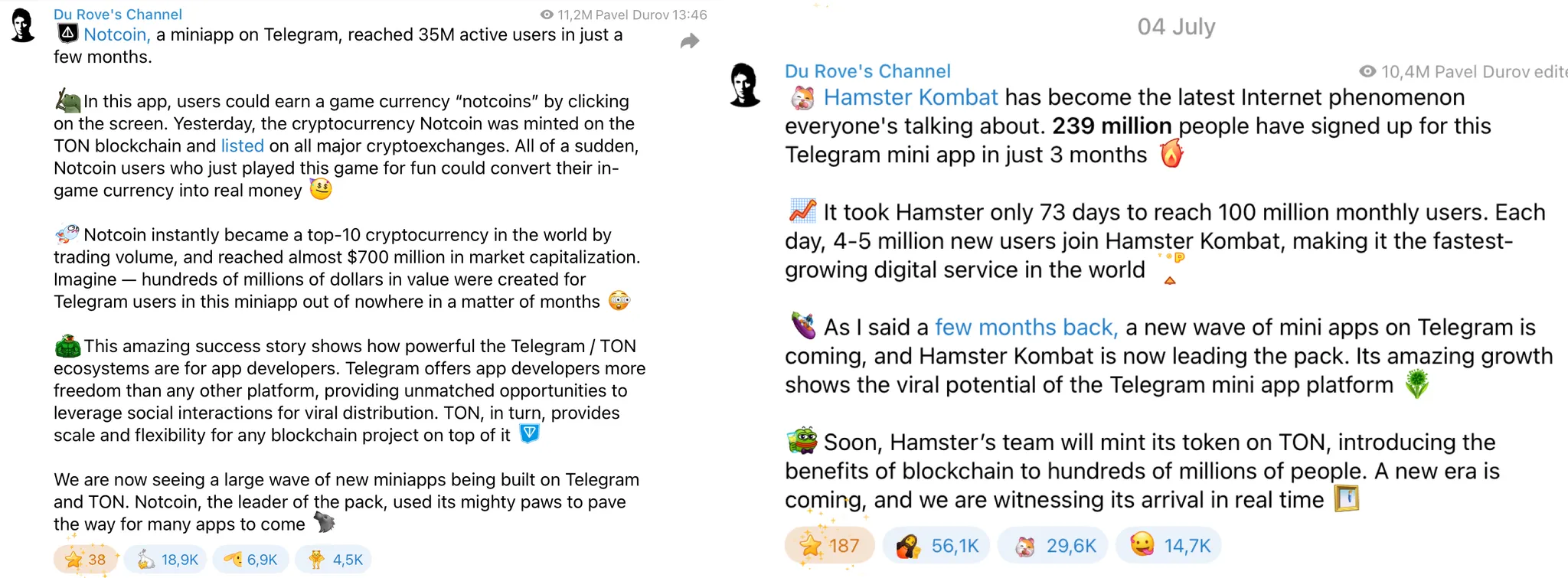
Source: Du Rove’s Channel
Notcoin's success proved the power of Telegram's vast user base in driving adoption, inspiring a wave of similar projects. Among these, Hamster Kombat stood out as another runaway hit, further validating the effectiveness of leveraging Telegram's social graph and user-friendly interface as a distribution strategy.
Launched in March 2024, Hamster Kombat amassed an astonishing 200 million users in just three months, igniting another Tap-to-Earn wave. Despite its primitive functionality and questionable sustainability, 200 million is an impressive figure even by Web2 standards. It far exceeds the current number of onchain application users worldwide, demonstrating the potential to attract mainstream users new to blockchain technology.
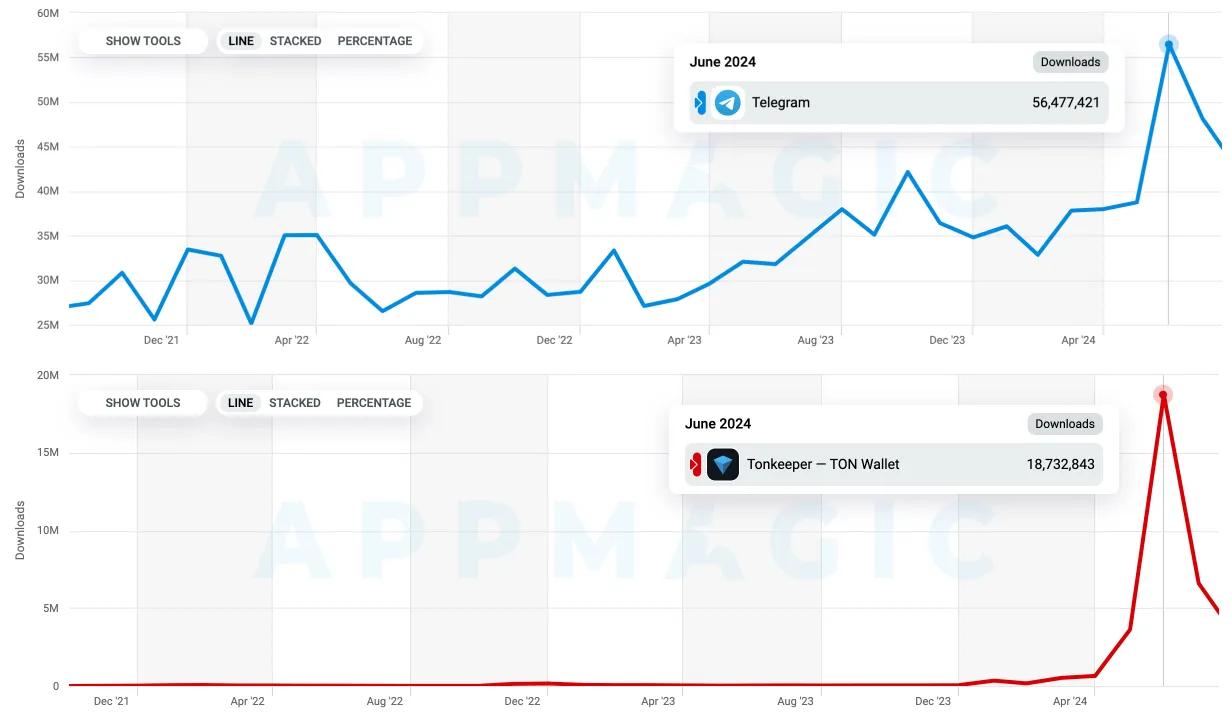
Source: How Has Hamster Kombat helped Telegram reach 700M+ MAU?
Hamster Kombat's success didn't just benefit itself; it gave Telegram a significant boost too. In June 2024, Telegram saw over 50 million new app installations, a staggering 45% increase from the previous month. Interestingly, TON Keeper, the non-custodial wallet app for TON, saw its downloads spike in tandem with Telegram's. This trend suggests that even simple apps can drive growth across the entire Telegram ecosystem.
Telegram mini-apps are now reaching over half a billion users, which is 50% of Telegram's nearly one billion user base. While Notcoin and Hamster Kombat are the headline-grabbers, other projects are making waves too. Take Catizen, for example – it's gained 30 million users and raked in over $20 million in just six months.
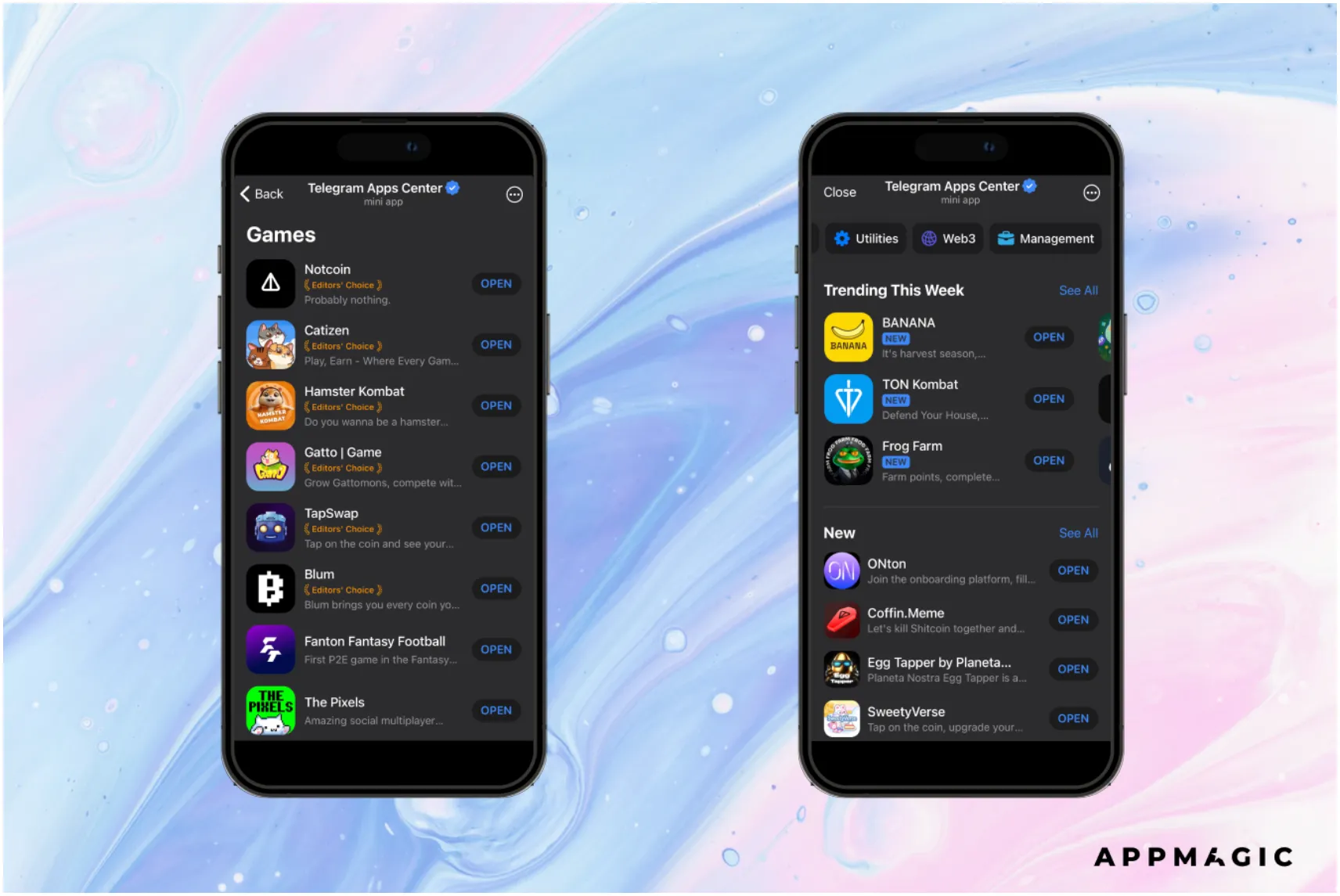
Source: How Has Hamster Kombat helped Telegram reach 700M+ MAU?
This proven success has led to a surge in new mini-apps. To help users navigate this growing ecosystem, TON Foundation launched the App Center last year. App Center is a one-stop shop for discovering and exploring various services, eliminating the need to scour multiple social media platforms or groups. Users can access these services with a single tap, either through bots or channels.
Adding to the convenience, Telegram recently introduced an in-app browser. This feature allows users to seamlessly navigate between mini-apps and web apps without leaving Telegram, much like using Safari or Chrome within the app. The App Center has been a runaway success, now hosting over 1,000 applications and boasting more than 5 million monthly active users. It has blown past its 2-3 year growth targets in less than 12 months, and still shows no signs of slowing down.
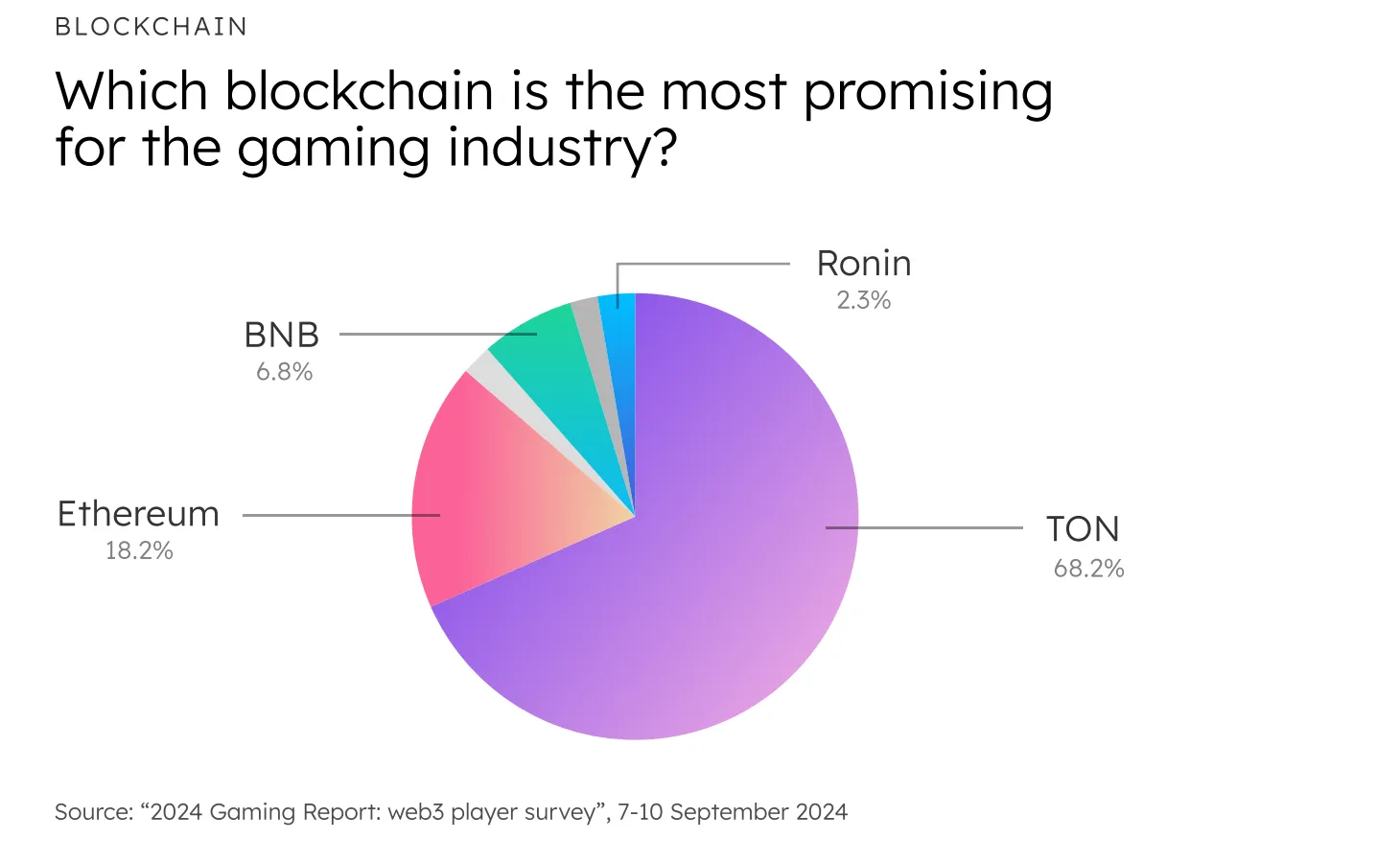
Source: Global Gaming Report 2024
Gaming has emerged as a standout sector in the TON ecosystem. Of the 1,000+ apps in the App Center, over 400 are GameFi projects. TON is rapidly becoming the go-to platform for blockchain gaming, with both players and developers recognizing its potential. Telegram sees games that leverage social graphs as a key driver of user acquisition and is actively promoting this approach internally.
To fuel this growth, TON Ventures has launched a $40 million fund dedicated to GameFi. They're also rolling out initiatives like the Open League incentive program, offering grants, and providing marketing support through the Trending App channel and targeted advertising.
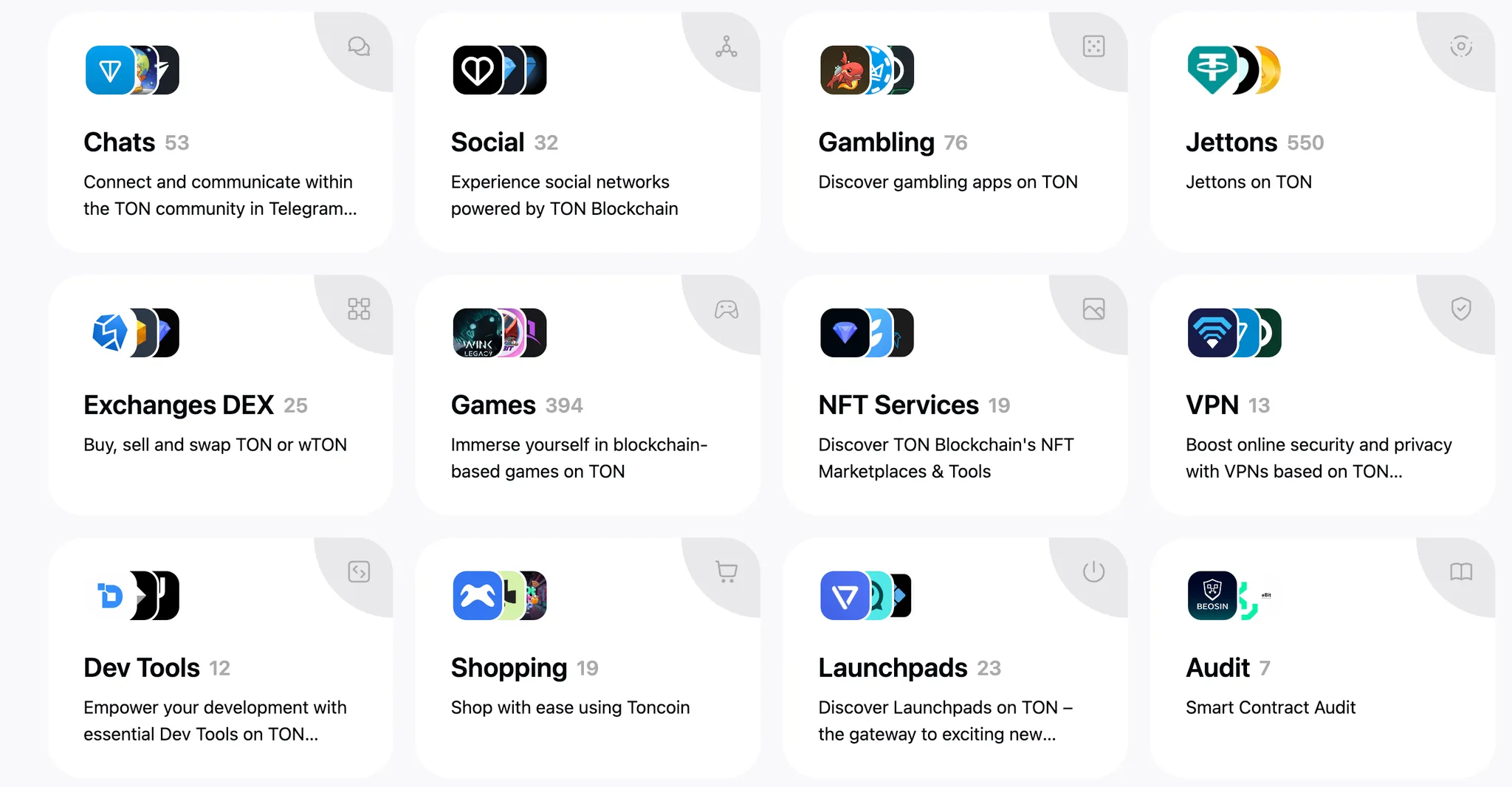
Source: Ton APP
As the ecosystem matures, we're seeing a shift in both the variety and quality of applications. While many TMAs on TON still rely on basic mechanics like click-to-earn rewards, referral systems, and idle token farming, the landscape is diversifying.
The success stories of Notcoin, Hamster Kombat, and Catizen have showcased the power of Telegram's massive user base. This has attracted a wider range of projects, improving the overall quality of user experiences. The ecosystem is no longer limited to simple games. We're now seeing the emergence of basic DeFi services like DEXs and LSTs. Consumer applications are branching out too, with SocialFi platforms, memecoin launchpads and prediction markets joining the mix. This diversification points to a more varied and sophisticated ecosystem taking shape.
The 2010s saw the rise of 'super apps' - platforms that integrate a wide range of daily services into a single interface. WeChat in China, Kakao in South Korea, and Grab and Gojek in Southeast Asia are prime examples of this phenomenon.
These super apps often follow a similar growth pattern. They start with a core service that attracts a large user base - typically messaging or ride-hailing - and then expand their offerings. WeChat, for instance, began as a simple chat app in 2011 and has since grown to serve over 1.2 billion monthly active users with a diverse array of features.
The secret sauce of super apps is their ability to create powerful network effects while offering unparalleled convenience. By catering to specific cultural or regional needs, they've become indispensable in users' daily lives. Take Kakao, which is used by more than 90% of South Koreans and covers everything from messaging and banking to shopping and transportation.
The crypto world, however, has yet to produce its own super app. While some wallet and exchange apps offer multiple functions, they've largely remained confined to trading and haven't developed the same level of user engagement or network effects as their Web2 counterparts.
Yet, the potential for a crypto super app is undeniable, especially if it can integrate seamlessly into users' daily routines. This is where the TON-Telegram partnership becomes particularly interesting.
In this chapter, we'll explore TON's prospects of becoming the crypto world's first true super app. We'll examine how it might overcome crypto's accessibility hurdles and harness Telegram's massive user base to achieve this ambitious goal.

Source: Privy
Despite the increasing abstraction of blockchain technology and the emergence of more user-friendly applications, the crypto world remains daunting for the average Web2 user. Newcomers face a barrage of unfamiliar concepts - from cryptocurrencies and NFTs to wallets and transactions - creating a steep learning curve that can be off-putting.
The financial nature of most crypto apps compounds this problem. Many require users to invest or deposit assets from the get-go, a significant ask for those just dipping their toes in the water. While recent advances in account and chain abstraction have streamlined onboarding, the requirement for upfront financial commitment still hinders the gradual adoption process that allows users to learn and potentially evolve into high-value participants.
Bridging this gap between the familiar Web2 landscape and the seemingly alien world of onchain interactions calls for a more nuanced, granular approach. Even with simplified interfaces, if there's no compelling reason for new users to take that first step of installing a wallet and transferring funds, all these efforts may fall flat.

Telegram-based applications shine in their ability to lower these entry barriers. Users can instantly access a variety of crypto applications through Telegram's App Center or search function, without the need for additional downloads. Interaction with crypto features becomes seamless, utilizing either Telegram's built-in Wallet or separate non-custodial wallets, effectively sidestepping complex wallet setup procedures.
Unlike DeFi apps, which are primarily financial tools, social or consumer applications geared towards entertainment don't typically command strong user commitment. Users are prone to quick abandonment at the slightest inconvenience. This is where Telegram's integration of crypto services becomes a game-changer. The ability to access these services with just a few taps within an app users already engage with daily significantly reduces psychological barriers, allowing for a gradual acclimation to the crypto ecosystem.
The mobile-first nature of Telegram-based applications is another key advantage. Consumer apps, designed for daily use and frequent micro-transactions, demand a seamless mobile experience. Many existing onchain applications, primarily built for desktop, struggle to deliver a smooth mobile experience. The TON ecosystem, in contrast, leverages Telegram's inherent mobile-friendliness, giving it a significant edge in appealing to the average consumer.
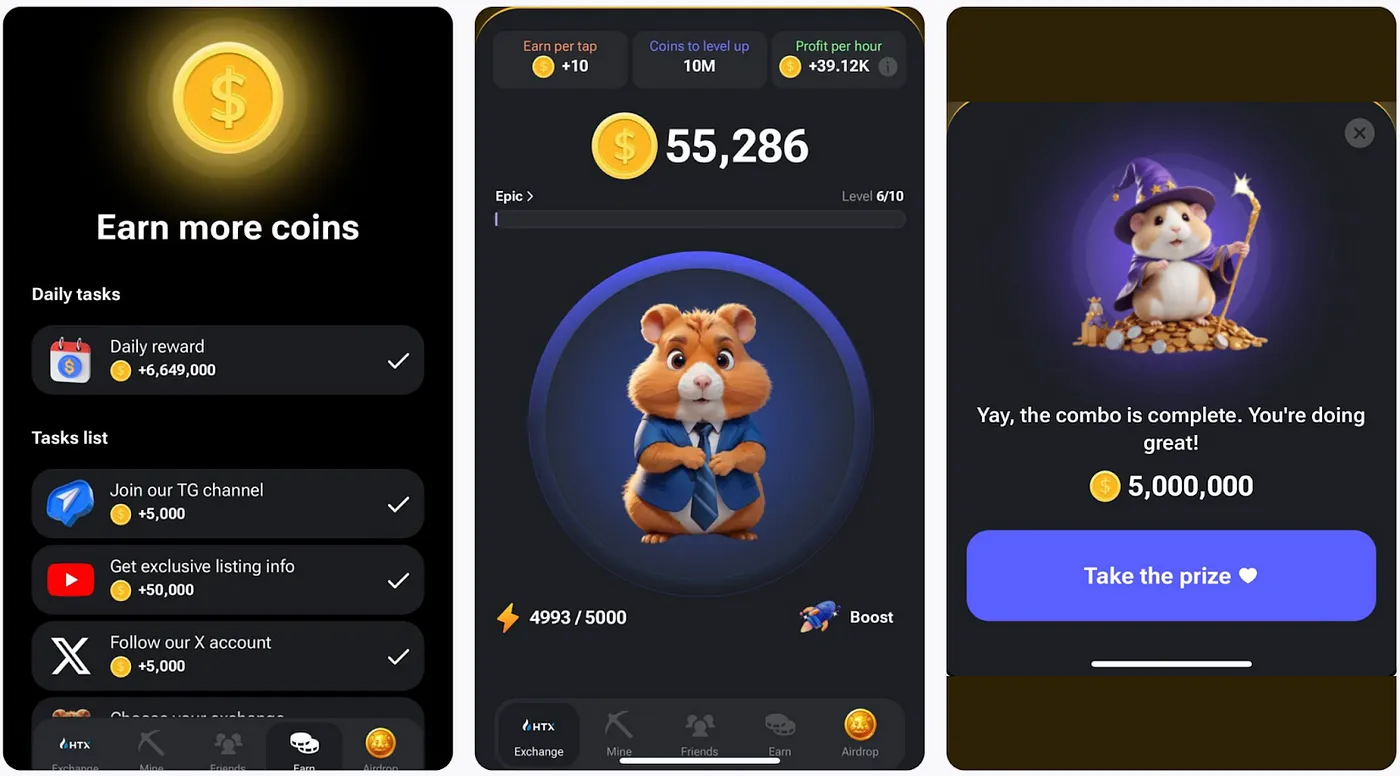
Source: Hamster Kombat
In this sense, the fact that T2E models were the first success case in TON ecosystem is worth noticing. While T2E may not be groundbreaking in terms of user experience or long-term growth, it serves a similar purpose to meme coins in the broader crypto space - acting as a gateway for new users. These models effectively blend the allure of quick crypto gains with Telegram's accessibility.
T2E's appeal lies in its risk-free nature and simplicity. Users can earn without initial investment, and the mechanics are straightforward enough for anyone to grasp. The catch comes when users want to cash out their earnings, as they must navigate the typical crypto onboarding process, including wallet setup and exchange registration. This incentive-driven step often leads to higher conversion rates, even when the complexity is identical.
This initial foray into crypto familiarizes users with fundamental concepts like wallets, tokens, and NFTs. Armed with this basic knowledge, users are better equipped to explore more sophisticated services, potentially venturing into DeFi or NFT trading within the broader crypto ecosystem.
The implications of Telegram's low-barrier mini-apps extend far beyond simple games or the TON ecosystem's growth. Starting with accessible models like T2E, users can gradually engage with increasingly complex and diverse crypto services. This incremental approach could be key to driving mainstream adoption and integrating crypto into everyday life. By addressing the 'first mile problem' that has long plagued the crypto industry, the TON ecosystem is positioning itself as a fresh gateway to the world of crypto.
The crypto world currently suffers from a lack of organized platforms for discovering onchain applications. This void creates a significant hurdle for average users in even becoming aware of, let alone finding, these applications. While crypto enthusiasts and a select group of experts can navigate this complex landscape, the majority of users are unwilling to invest the time and effort required to overcome the steep learning curve associated with exploring new crypto services.
The problem is exacerbated by the fact that most crypto service advertising and distribution relies heavily on social networks. This means that users without pre-existing crypto-related connections find themselves with limited options for discovering and experimenting with onchain applications.
This challenge isn't unique to any one blockchain; it's a systemic issue across the entire crypto ecosystem. Even the most mature networks like Ethereum and Solana lack comprehensive, user-friendly distribution and discovery channels. The situation is somewhat better for established financial services like DeFi platforms or exchanges, which have proven their market fit and can be evaluated using concrete metrics such as TVL or trading volume. However, for consumer-focused applications, particularly new launches, avenues for user discovery and engagement remain scarce.
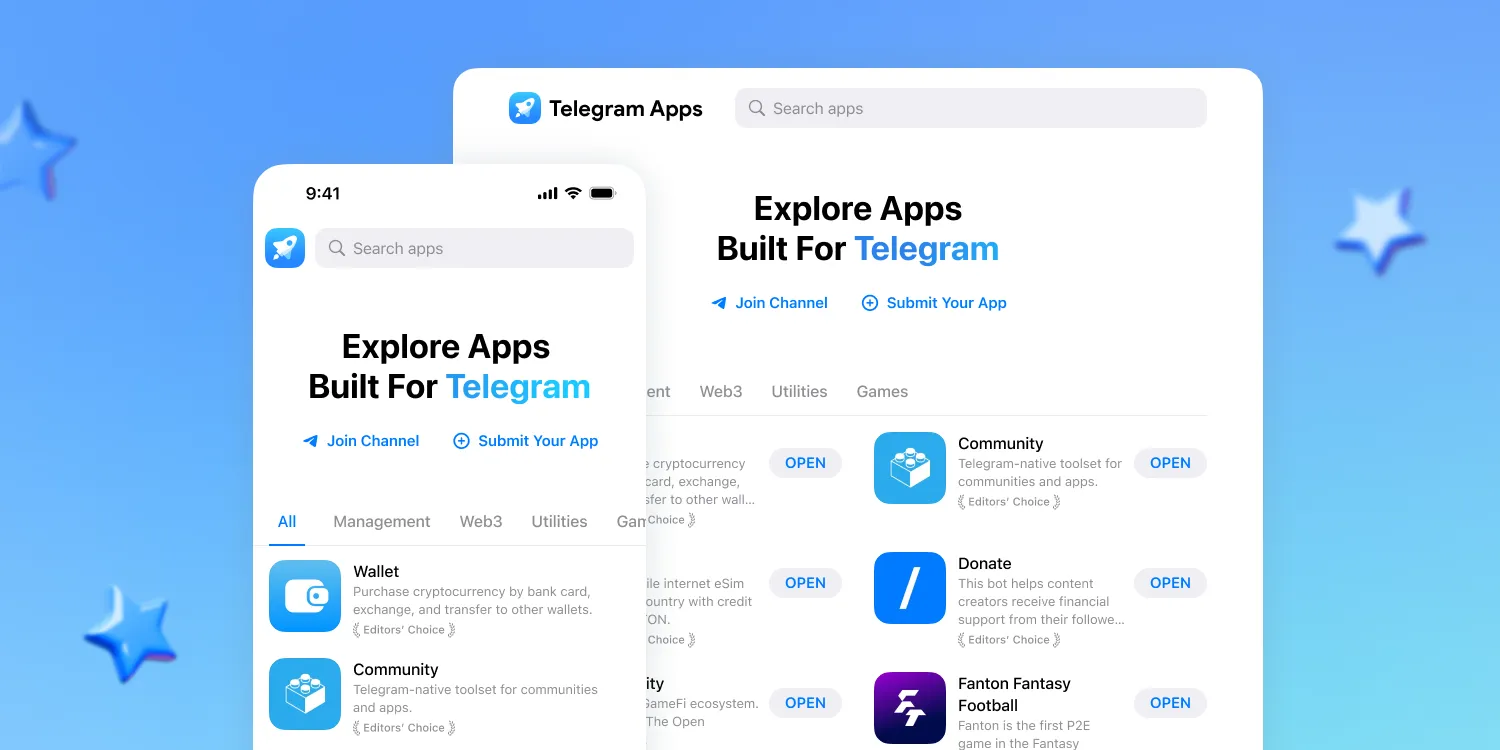
Source: TON Ecosystem Evolved: Introducing Telegram Apps Center
Telegram's App Center tackles this discovery problem by offering a centralized hub for users to explore and compare various services. This allows users to efficiently find desired services without the need to search through multiple channels.
The App Center's design deliberately mirrors that of Apple's App Store, leveraging a familiar interface that most users are already comfortable with. This strategic choice allows users to browse games and applications within Telegram in much the same way they would traditional apps. The result is a more intuitive discovery process for crypto applications, one that doesn't necessarily require users to be consciously engaged with blockchain concepts.
Telegram has further enhanced accessibility with a recent update that integrates application discovery directly into the chat search function. This subtle yet powerful feature allows users to organically discover new applications during their everyday messaging activities, without needing to explicitly access the App Center. By weaving application discovery into the fabric of daily use, Telegram is significantly lowering the barrier to entry for crypto applications.

Source: How Apple’s App Store Hurdles Are Hindering DApp Development
Telegram's unique application distribution channel offers a potential workaround to the often restrictive regulations and censorship imposed by traditional app stores. Currently, app stores implement quite strict censorship and regulation on crypto applications. The concept of "in-app purchases" as defined in Apple's App Store guidelines often doesn't align with blockchain fee structures, causing confusion for application developers and potentially leading to policy violations.
While these regulations are partly designed to protect users from potential threats, they inadvertently stifle innovation in the crypto space, especially given the current unfavorable regulatory environment. This regulatory friction is often cited as a key factor in the slower adoption of crypto applications in mobile environments compared to desktop platforms.
In this context, Telegram's App Center emerges as a beacon of opportunity for crypto developers. By providing a avenue to sidestep app store restrictions while still reaching a vast user base, the App Center has the potential to catalyze innovation and experimentation in the mobile-friendly onchain ecosystem.
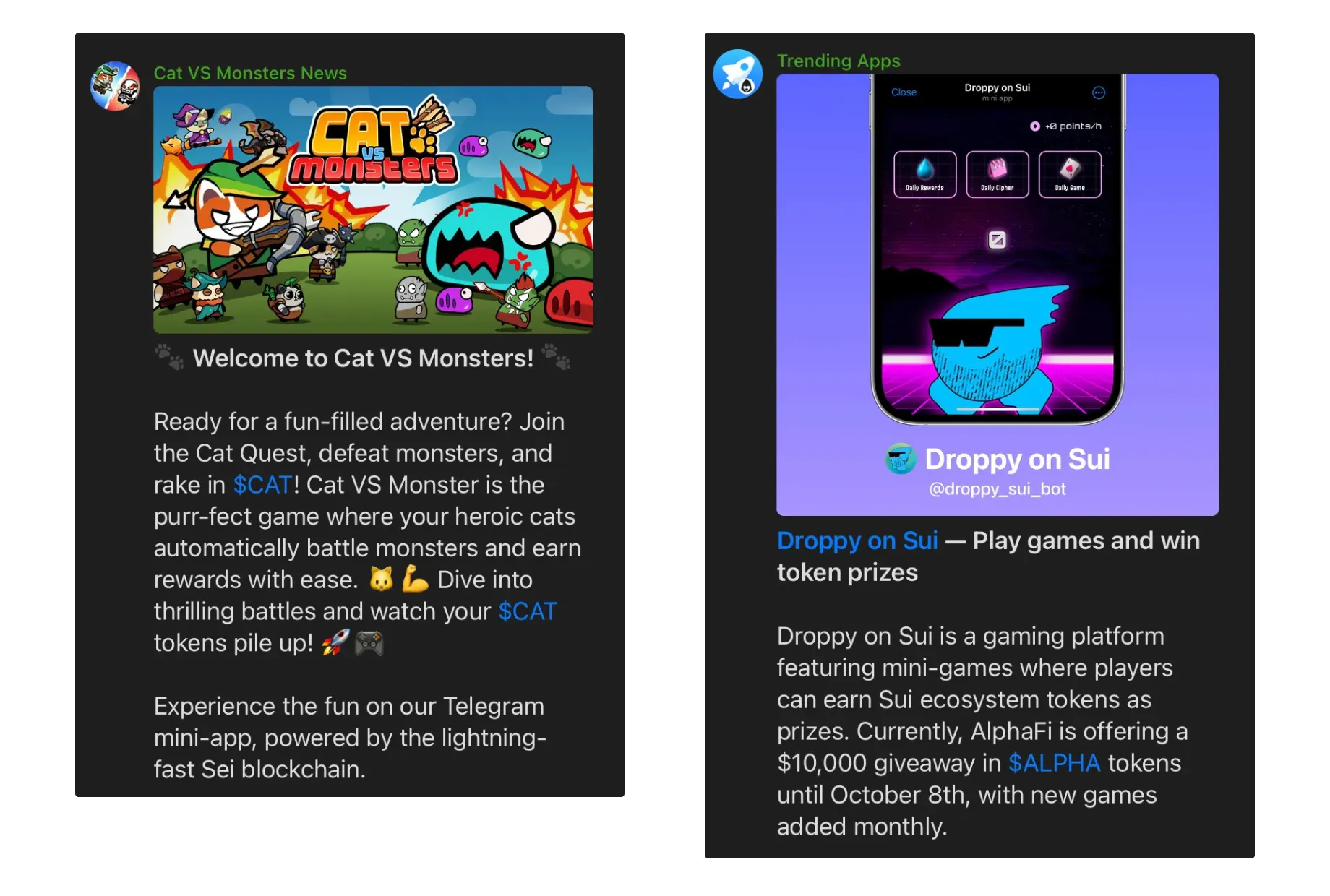
Telegram has recently made it clear that its mini-apps and App Center will be a platform for a broader crypto application ecosystem beyond just the TON ecosystem. This means that other chains or wallets can also use Telegram's infrastructure to deploy their services. Such an inclusive approach underscores Telegram's ambition to evolve into a comprehensive crypto platform, rather than a walled garden tied to a single blockchain.
Through this, Telegram aims to become a hub for diverse crypto projects, attracting wider public interest and ultimately building a "super app that encompasses everything" like WeChat. The endgame is a seamlessly integrated platform where users can access a spectrum of services - from finance and social networking to entertainment - all within a unified interface.
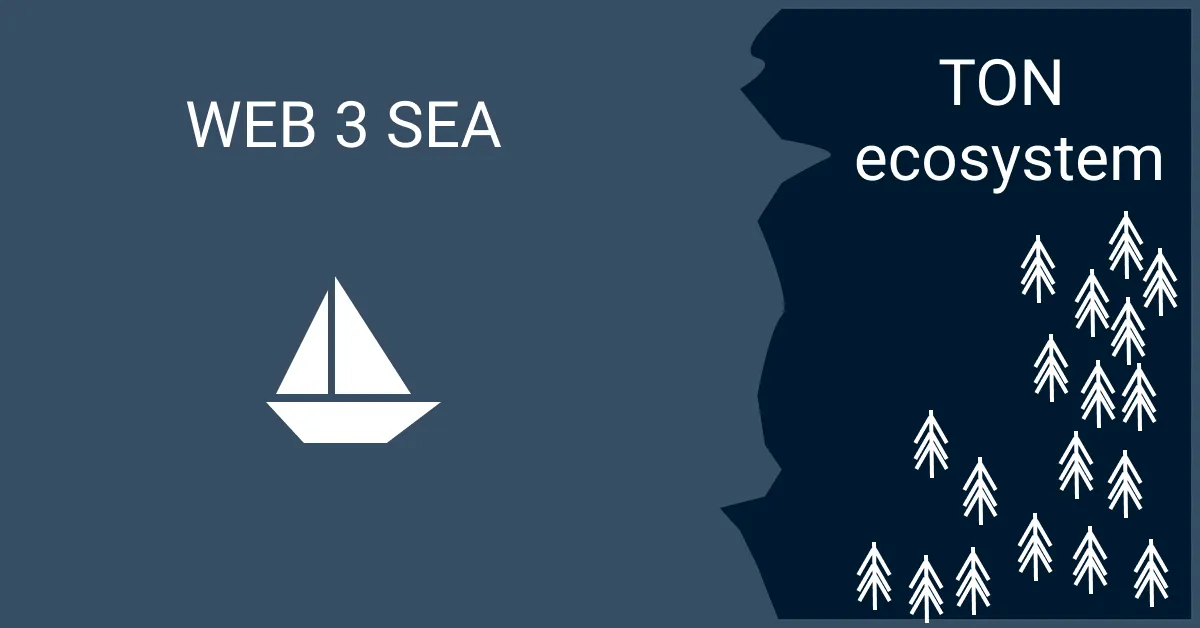
Source: FunC Journey: Part 1
TON's ecosystem stands apart from the mainstream crypto landscape, both in its cultural dynamics and technical approach. This isolation poses a significant challenge to TON's aspirations of becoming a super app in the crypto world.
Launched in 2021, TON emerged during a period when ecosystem integration was still in its early stages. Since then, it has charted its own course, largely detached from the broader crypto community. This independent trajectory has led to a technology stack and infrastructure that diverges significantly from other blockchain platforms. The differences go beyond mere development philosophy; they're deeply embedded in the fundamental architecture and technical choices made by the TON team.
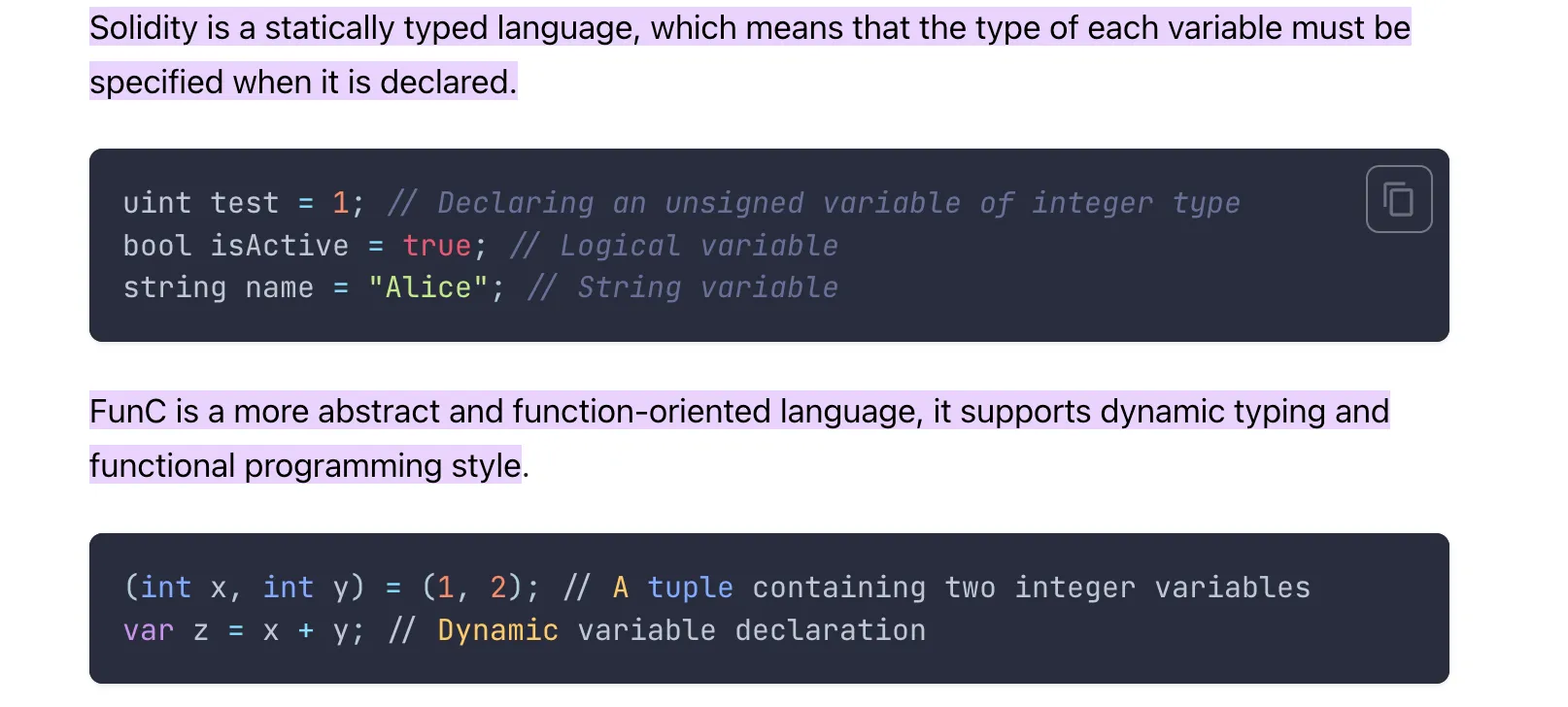
Source: Solidity vs. FunC
TON's infrastructure sets it apart from other blockchain ecosystems. Its unique approach to sharding and data structures, coupled with its proprietary TON Virtual Machine (TVM), creates a fundamentally different environment compared to the more prevalent EVM-based or Move-based chains. This divergence impacts not only the execution environment but also the entire blockchain architecture and smart contract development process. For example, TVM's stack-based architecture contrasts sharply with EVM's register-based approach.
Further distinguishing TON is its use of niche languages like FunC and Tact for smart contract development. These languages, while innovative, present a steep learning curve for developers accustomed to more mainstream options like Solidity or Rust. FunC, the primary low-level language used in TON, has C-like syntax but strongly emphasizes functional programming, requiring new learning for developers.
These technical peculiarities have far-reaching implications beyond mere development hurdles. They potentially isolate TON's ecosystem, hampering interoperability with other blockchains and complicating cross-chain or multi-chain application development. Moreover, the stark differences in development environments create a noticeable gap in available middleware – such as indexing tools and oracles – compared to major blockchain infras. This disparity further compounds the challenges of developing robust onchain applications within the TON ecosystem.
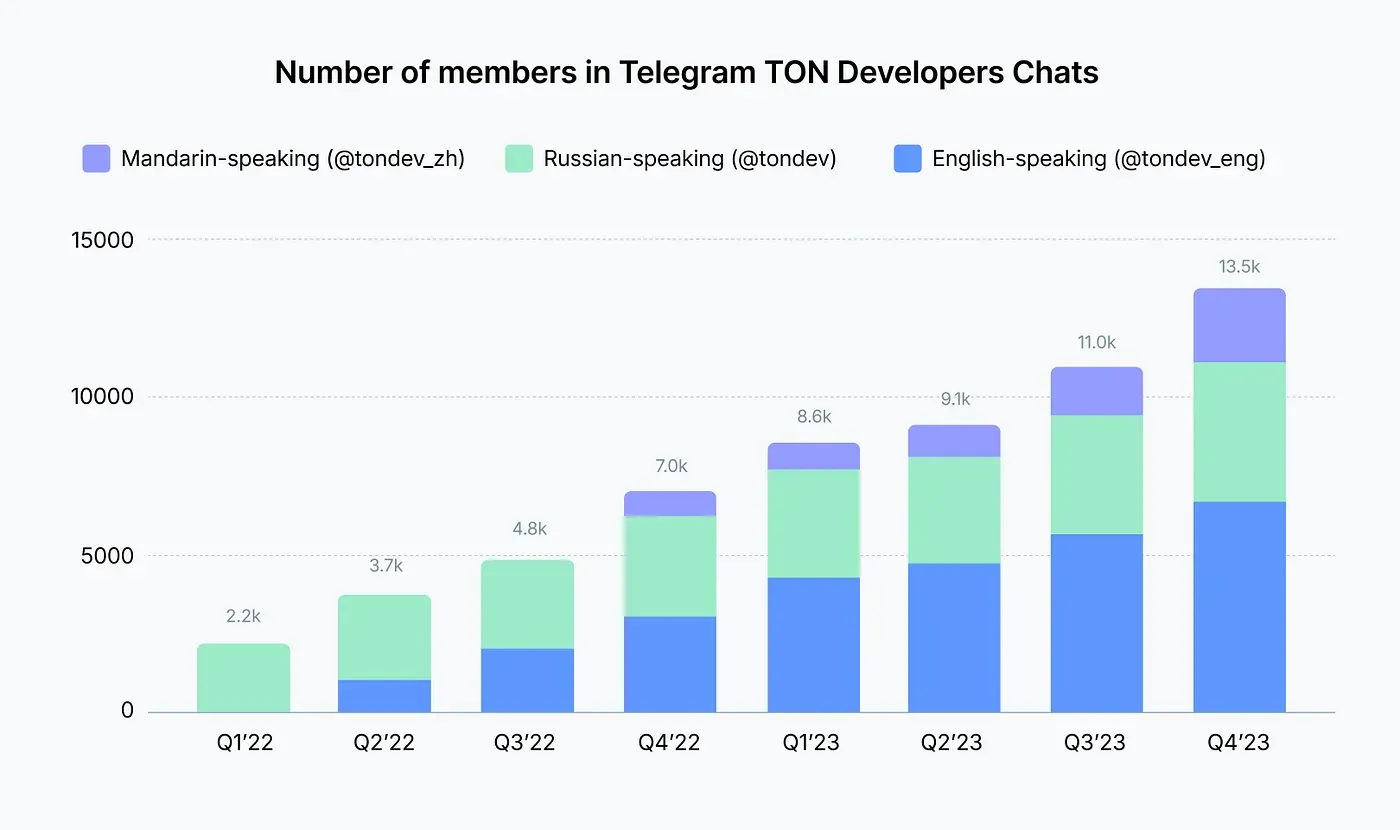
Source: Why Telegram Mini Apps Are The Game Changer For Web3 Adoption And Beyond
Also, the cultural landscape of TON's ecosystem stands in stark contrast to the mainstream crypto community. Its user and developer base is heavily concentrated in Russia and East Asia, which leads to more than just a different geographical spread. This concentration fundamentally shapes communication styles, development practices, and approaches to service design within the TON community.
These regions not only face language barriers with the English-speaking world but also among themselves. Unlike in the West, where English serves as a lingua franca, users and developers in these Eastern countries often have lower English proficiency and tend to operate within their own language. This language divide creates significant hurdles for smooth information exchange and collaboration with the broader global crypto community.
While crypto native users often navigate English with ease regardless of their region, language presents a formidable barrier when targeting a broader user base. This challenge transcends simple translation, influencing every aspect of product development - from service localization and marketing approaches to the nuances of user experience design. For example, an app catering to Russian speakers may require a completely different UX/UI approach and community engagement strategy compared to one designed for an English-speaking audience. These cultural and linguistic nuances can significantly impact user adoption and engagement, potentially limiting the global reach of TON-based applications.
This separation from the English-speaking world doesn't necessarily preclude significant success. Interestingly, super apps, while rare in the US or Western countries, have found remarkable success in Eastern cultures, as evidenced by WeChat, Grab, and Line. These successes often stem from the siloed but homogeneous nature of many Eastern markets, where strong localization needs create barriers to entry for global services. This environment has fostered the growth of dominant local players in relatively sheltered competitive landscapes.
Telegram's massive user base, which far exceeds the entire crypto population, certainly provides a solid foundation for building a self-sustaining ecosystem. However, the crypto industry operates in a uniquely borderless digital realm. In this context, TON's cultural and linguistic isolation could prove to be a double-edged sword. While it may provide a captive audience, it could also hinder TON's aspirations of becoming a truly global crypto super app, capable of bridging diverse communities and use cases across the crypto landscape.
The user experience in TON-based applications remains a work in progress. The challenges extend beyond simple interface design, encompassing broader issues in system architecture and user journey.
Despite the strong connection between the TON Foundation and Telegram, crypto functionality is not yet at the forefront of the Telegram experience. The App Center, for instance, is tucked away as a feature that users must actively seek out, rather than being seamlessly integrated into the main interface. This setup means that users are unlikely to stumble upon crypto features organically; instead, discovery relies heavily on deliberate exploration, viral spread or promotion.
The cautious approach to integrating crypto features may be influenced by regulatory concerns. The recent detention of Telegram's CEO, Pavel Durov, by French authorities underscores the potential legal risks associated with crypto functionalities. This incident raises questions about how boldly Telegram will promote crypto-related features in the future, given the complex and often uncertain regulatory landscape surrounding digital assets.
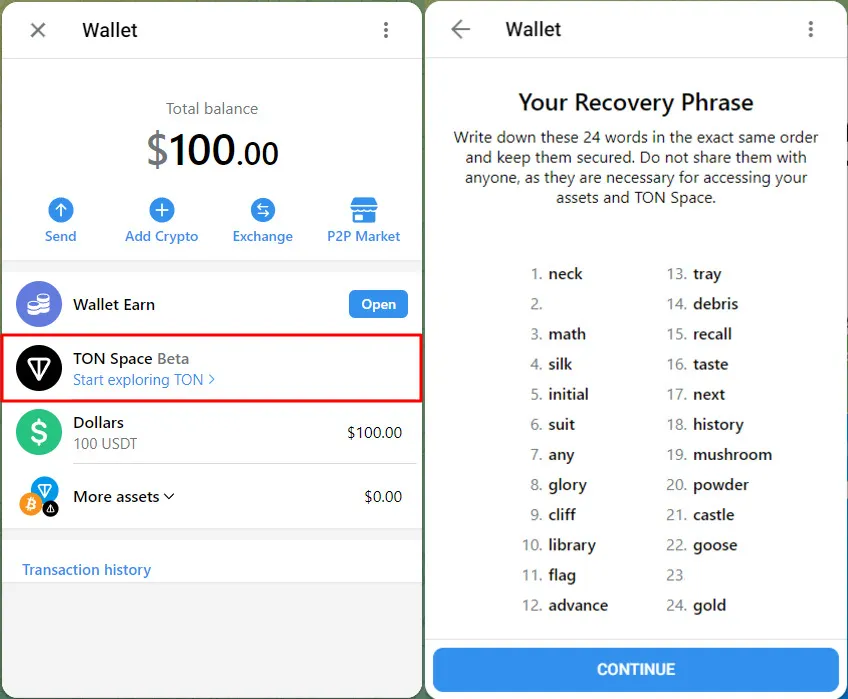
Source: Telegram Wallet
The coexistence of centralized and decentralized solutions within the TON ecosystem creates a notable user experience gap. Telegram's built-in "Wallet" is a custodial solution, akin to a centralized exchange wallet, confined to the Telegram app environment. This wallet restricts users from accessing private keys or receiving a wide range of assets. Its current functionality is limited to handling the native TON token and a select few Jettons (TON's version of ERC-20 tokens), such as USDT, Notcoin, and Hamster tokens.
For users looking to fully engage with the onchain ecosystem, a separate non-custodial wallet like Ton Space must be activated. This additional step introduces familiar challenges companied with traditional crypto wallets, including the management of seed phrases. The resulting dual wallet system - a custodial solution within Telegram and a separate non-custodial option - can be particularly confusing for crypto newcomers.
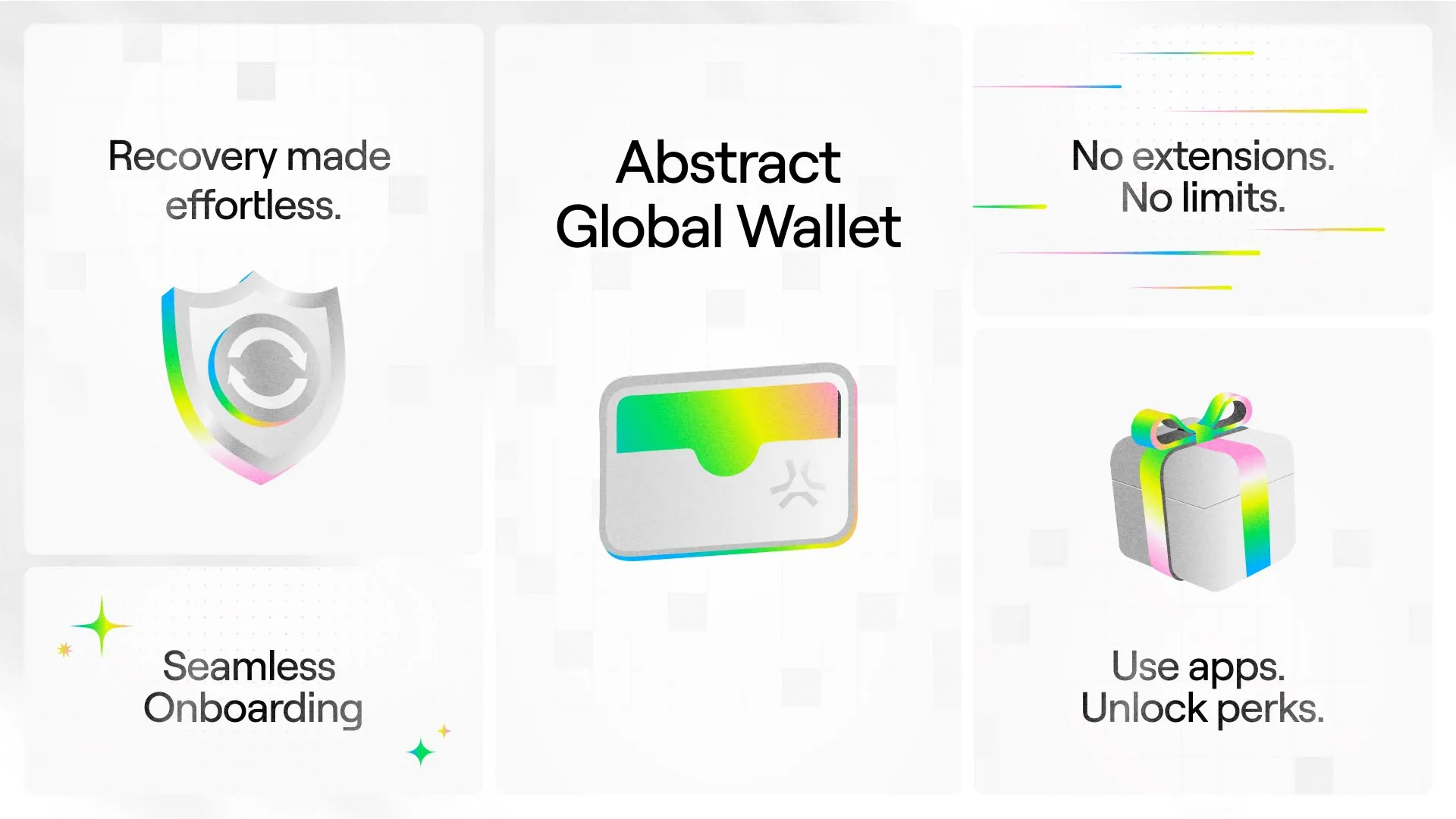
Source: X(@AbstractChain)
TON's wallet strategy appears to lag behind recent innovations in wallet user experience, particularly those seen in EVM-compatible chains. For example, solutions like Abstract Global Wallet, which leverages Privy's account abstraction, have significantly simplified private key management through techniques like Shamir Secret Sharing. These advanced approaches even allow users to operate Smart Wallets using existing externally owned accounts (EOAs) or social media logins, dramatically lowering the barrier to entry.
While Telegram's vast user base provides an impressive distribution channel for TON, the platform still has considerable room for improvement in terms of user experience innovation and technological sophistication. To truly realize its potential as a crypto super app, Telegram needs to more seamlessly integrate crypto functionalities into its core experience. This integration should be coupled with the development of more intuitive infrastructure and interface designs, creating a user journey that feels natural and accessible to both crypto novices and experts alike.
The TON ecosystem has experienced rapid expansion, yet it faces a significant challenge: the quality and sustainability of its applications. While the platform boasts an impressive number of users, a closer look reveals a user base primarily composed of low-value participants engaging in small unit volume transactions. This imbalance could potentially impede the ecosystem's long-term growth and development.
At the heart of this issue lies the current state of TON applications. Even the ecosystem's most successful projects, such as Notcoin, Hamster Kombat, and Catizen, rely heavily on simplistic game mechanics and idle token farming strategies. These applications are designed around short-term incentives and rewards, a model that, while effective for initial user acquisition, often struggles to maintain long-term engagement or create lasting value. This approach raises questions about the ecosystem's ability to foster sustained user interest and generate meaningful economic activity over time.
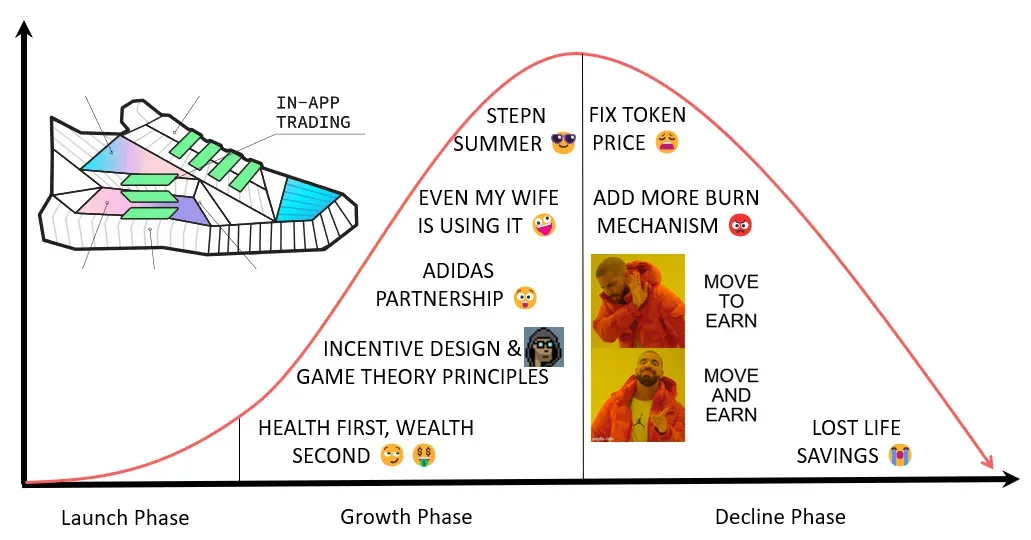
Source: Why STEPN’s Collapse Is Inevitable?
The simplicity and low quality of these applications raise serious concerns about their long-term viability. Drawing parallels with past trends like M2E or SocialFi, we can observe a common pattern: T2E and idler games often experience a rapid penetration in popularity, followed by a rapid decline in user engagement. This volatility stems from their lack of inherent entertainment value or depth, relying instead on token rewards as the primary draw. Such a model is unlikely to sustain user interest or foster genuine ecosystem growth over time.
The composition of TON's user base presents another challenge. While the platform boasts impressive user acquisition numbers, a closer look reveals a predominance of users engaging in low-volume transactions. This demographic pattern stems from TON's strong adoption in regions with emerging economies, such as parts of Eastern Europe, Africa, and Southeast Asia. Users from these areas tend to participate in smaller-scale transactions and more modest economic activities. While this broad adoption demonstrates TON's global reach, it also raises questions about the ecosystem's capacity to generate substantial economic value in its current state. The challenge lies in leveraging this wide user base to foster more robust economic activity and value creation within the TON ecosystem.
Moreover, this user base often exhibits limited platform loyalty, driven primarily by short-term economic incentives. Users tend to gravitate towards platforms offering the most attractive rewards, leading to high churn rates for individual applications. This nomadic user behavior presents a significant challenge in cultivating stable, enduring communities within the TON ecosystem.
While user traffic remains a critical metric for consumer-oriented platforms, an ecosystem built solely on inflated user numbers or transaction volumes fueled by short-term incentives lacks the robust foundation needed for lasting success. To foster a truly thriving ecosystem, TON needs to shift its focus towards developing high-quality, sustainable applications that can attract and retain a more valuable user base. This transition from quantity to quality is crucial for building an ecosystem that can generate meaningful economic activity and withstand the test of time in the highly competitive blockchain landscape.
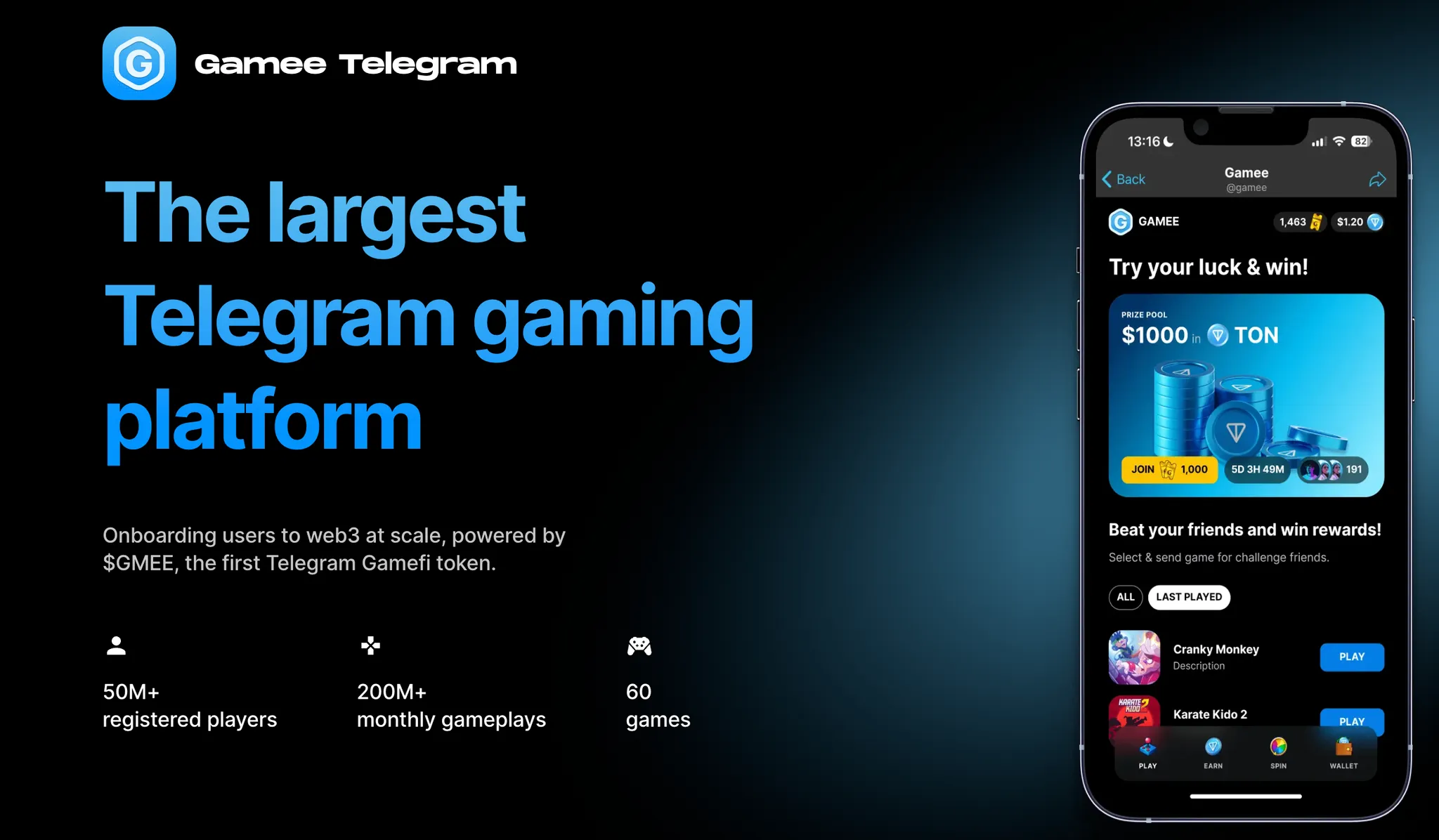
Source: GAMEE
Despite these challenges, the initial success of mini apps on TON has effectively demonstrated the power of Telegram's distribution channel. This early traction has set the stage for potentially higher-quality applications to enter the TON ecosystem in the future.
While the constraints of mini-apps may limit the influx of AAA-quality games, the gradual increase in decent-quality casual games, such as those offered by GAMEE, is an encouraging sign of ecosystem maturation.
Perhaps more promising is the broadening spectrum of application types within the TON ecosystem. What began as a GameFi-centric platform is now expanding into various categories that have already proven their PMF in the crypto industry. This includes areas like SocialFi, memecoin launchpads, gambling and prediction markets.
These diversification trends could catalyze a qualitative shift in TON's user base. For TON to truly evolve, it will be crucial to onboard applications that offer rich social contexts and foster continuous user engagement. Such applications can help retain and nurture the user base initially attracted by simpler games, potentially transforming casual users into more committed, value-generating participants in the ecosystem.
The collaboration between TON and Telegram is forging a groundbreaking testbed for the crypto ecosystem, unparalleled in scale and potential. TON's competitive edge stems from Telegram's massive user base of nearly a billion monthly active users, coupled with a frictionless onboarding process and a powerful distribution channel via the App Center. The rapid success of projects like Notcoin and Hamster Kombat, which attracted millions of users within months despite their basic features, serves as a testament to the immense potential of their strategic move.
Nevertheless, the TON ecosystem isn't without its hurdles. While the meteoric rise of T2E games is impressive, there's a concerning reliance on simplistic click-and-reward mechanisms. The user base, while large, predominantly consists of low-value players with minimal platform loyalty, casting doubt on the long-term viability of both the ecosystem and its services. Furthermore, TON's unique technical architecture, including its distinct blockchain structure, execution environment, and bespoke programming languages like FunC and Tact, risks isolating it from the broader crypto development community.
The TON ecosystem is still in its early stages, with vast untapped potential. Telegram's strengths could be leveraged in numerous ways, from developing robust social networks to creating seamless payment systems and sophisticated financial services. This versatility suggests that TON could evolve far beyond its current gaming focus, potentially becoming a comprehensive crypto platform.
The critical question is whether TON and Telegram can truly transform into a crypto "super app." Their success hinges on overcoming current obstacles and capitalizing on their unique advantages. Two key factors will determine their trajectory: Can TON diversify its offerings and attract innovative services beyond its initial successes? And perhaps more crucially, can it convert Telegram's massive user base into active crypto participants? The answers to these questions will shape TON's future as a potential crypto powerhouse.
Only time will tell how this ambitious project unfolds. Regardless of its ultimate success, the TON and Telegram collaboration marks a significant milestone in crypto's evolution. It offers invaluable insights into mass crypto adoption and the development of all-encompassing platforms. As the TON ecosystem grows, it will illuminate the impact of introducing crypto to a vast, established user base, highlighting both the challenges and opportunities in bringing crypto to the mainstream.
Dive into 'Narratives' that will be important in the next year